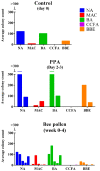Protective Effects of Bee Pollen on Multiple Propionic Acid-Induced Biochemical Autistic Features in a Rat Model
- PMID: 35888695
- PMCID: PMC9323335
- DOI: 10.3390/metabo12070571
Protective Effects of Bee Pollen on Multiple Propionic Acid-Induced Biochemical Autistic Features in a Rat Model
Abstract
Autism spectrum disorders (ASDs) are neurodevelopmental disorders that clinically presented as impaired social interaction, repetitive behaviors, and weakened communication. The use of bee pollen as a supplement rich in amino acids amino acids, vitamins, lipids, and countless bioactive substances may lead to the relief of oxidative stress, neuroinflammation, glutamate excitotoxicity, and impaired neurochemistry as etiological mechanisms autism. Thirty young male Western albino rats were randomly divided as: Group I-control; Group II, in which autism was induced by the oral administration of 250 mg propionic acid/kg body weight/day for three days followed by orally administered saline until the end of experiment and Group III, the bee pollen-treated group, in which the rats were treated with 250 mg/kg body weight of bee pollen for four weeks before autism was induced as described for Group II. Markers related to oxidative stress, apoptosis, inflammation, glutamate excitotoxicity, and neurochemistry were measured in the brain tissue. Our results indicated that while glutathione serotonin, dopamine, gamma-aminobutyric acid (GABA), GABA/Glutamate ratio, and vitamin C were significantly reduced in propionic acid-treated group (p < 0.05), glutamate, IFN-γ, IL-1A, IL-6, caspase-3, and lipid peroxide levels were significantly elevated (p < 0.05). Bee pollen supplementation demonstrates protective potency presented as amelioration of most of the measured variables with significance range between (p < 0.05)−(p < 0.001).
Keywords: apoptosis; autism spectrum disorders; cytokines; gut microbiota; neurotransmitters; oxidative stress; propionic acid.
Conflict of interest statement
The authors declare no conflict of interest. The funders had no role in the design of the study; in the collection, analyses, or interpretation of data; in the writing of the manuscript; or in the decision to publish the results.
Figures


References
-
- Volkmar F., Wiesner L. Essential Clinical Guide to Understanding and Treating Autism. John Wiley & Sons, Inc.; Hoboken, NJ, USA: 2017.
Grants and funding
LinkOut - more resources
Full Text Sources
Research Materials

